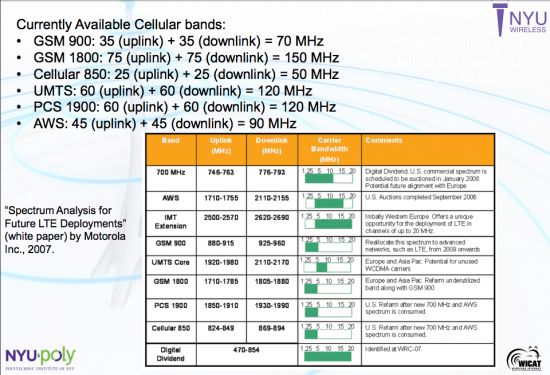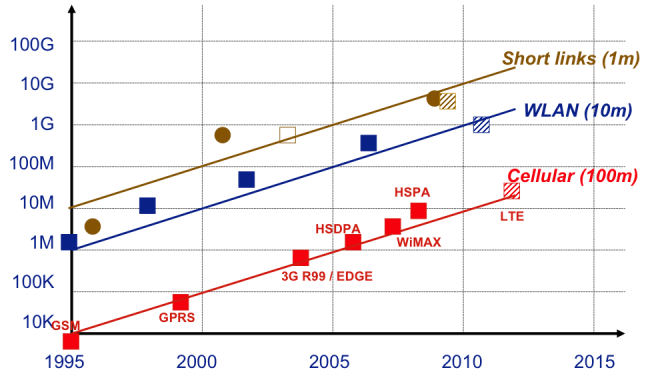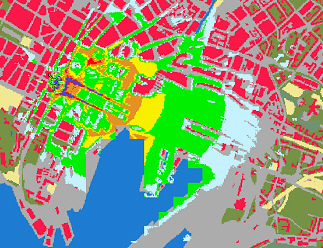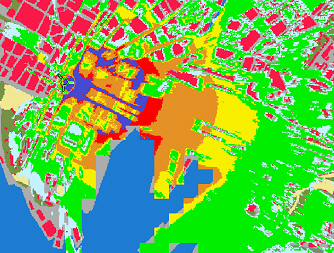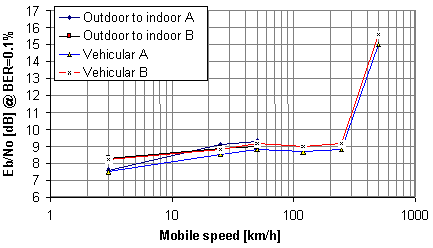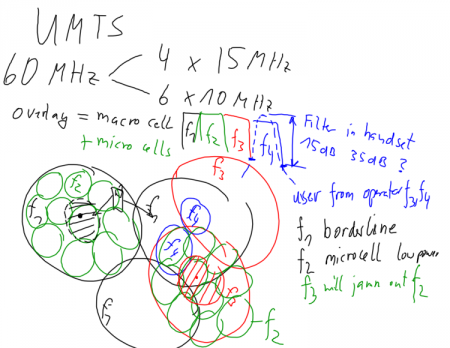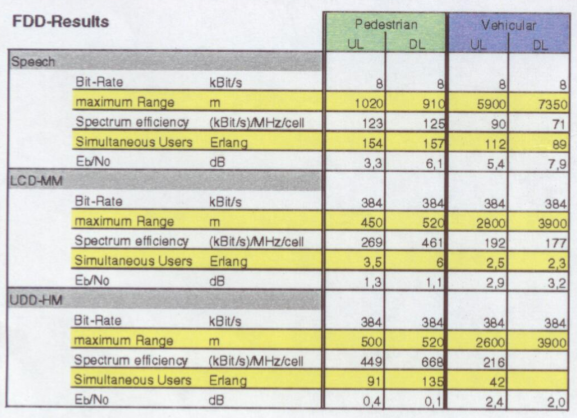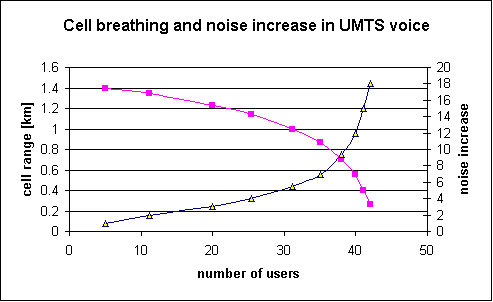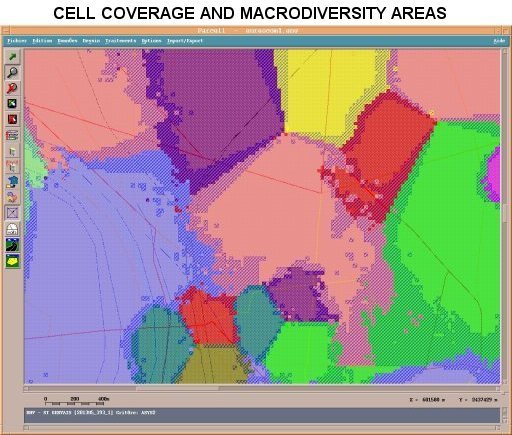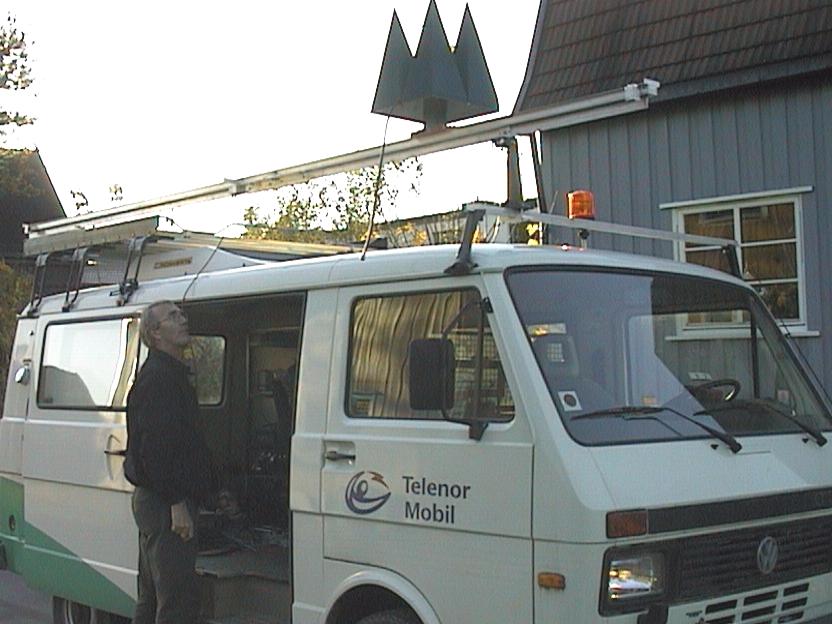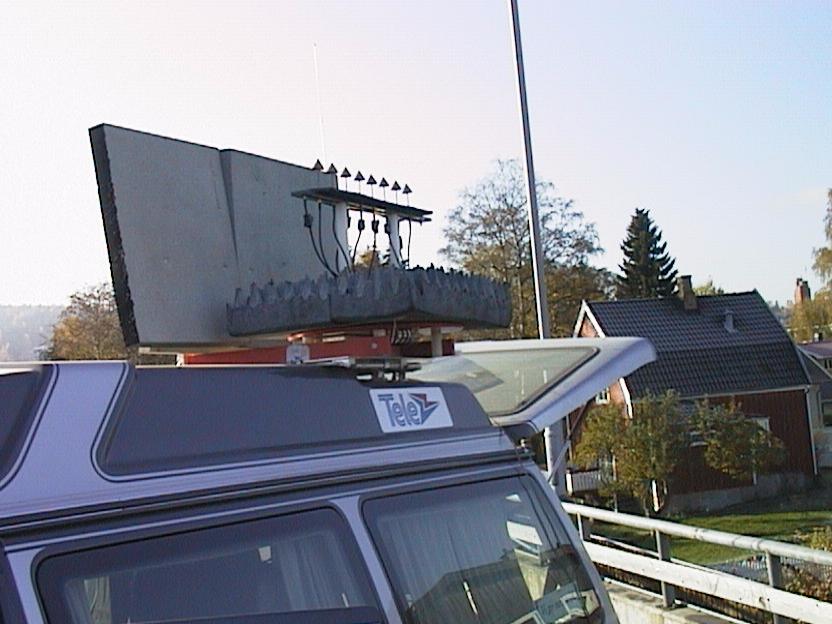Difference between revisions of "D4-Mobile Systems"
Josef.Noll (Talk | contribs) (→⌘Cell cover and macro-diversity areas) |
Josef.Noll (Talk | contribs) (→WIMAX) |
||
| (8 intermediate revisions by the same user not shown) | |||
| Line 80: | Line 80: | ||
== ⌘UMTS traffic simulations== | == ⌘UMTS traffic simulations== | ||
[[File:FDD-results.png]] | [[File:FDD-results.png]] | ||
| + | |||
| + | ''Note: voice, Low constraint delay (LCD, typical streaming) and Unconstrained data delay (UDD, typical ftp, email)'' | ||
(Source:Telenor FoU report 3-99) | (Source:Telenor FoU report 3-99) | ||
| Line 120: | Line 122: | ||
http://www.umtsworld.com/technology/wcdma.htm | http://www.umtsworld.com/technology/wcdma.htm | ||
| − | = | + | = ⌘4G/LTE technology = |
| − | * | + | * OFDMA based, time, frequency and code scheme, see: https://www.youtube.com/watch?v=Lu4I0iWhmZM |
| − | * | + | ** see: https://www.youtube.com/watch?v=QEpxtiN8Trc (from OFDM to OFDMA) |
| + | |||
| + | == ⌘LTE 450 MHz == | ||
LTE 450 pro's and con's from [http://450alliance.org/wp-content/uploads/2014/07/Ovum-LTE450-presentation.pdf Ovum conf. publication (.pdf)] | LTE 450 pro's and con's from [http://450alliance.org/wp-content/uploads/2014/07/Ovum-LTE450-presentation.pdf Ovum conf. publication (.pdf)] | ||
* Band 31, limited bandwidth of 2 x 10 MHz | * Band 31, limited bandwidth of 2 x 10 MHz | ||
| Line 128: | Line 132: | ||
[[File:LTE450_Ovum_pres.png|450px]] | [[File:LTE450_Ovum_pres.png|450px]] | ||
| − | =⌘ IMT-A: WiMAX, LTE = | + | =⌘ IMT-A (4G): WiMAX, LTE = |
IMT-Advanced (IMT-A) is often called the 4G standard for Mobile Communications. Both WiMAX through the 802.16e and LTE provide technologies for achieving higher data throughput. | IMT-Advanced (IMT-A) is often called the 4G standard for Mobile Communications. Both WiMAX through the 802.16e and LTE provide technologies for achieving higher data throughput. | ||
| Line 135: | Line 139: | ||
Evolution of radio spectrum, and frequency bands for LTE | Evolution of radio spectrum, and frequency bands for LTE | ||
http://www.radio-electronics.com/info/cellulartelecomms/lte-long-term-evolution/lte-frequency-spectrum.php | http://www.radio-electronics.com/info/cellulartelecomms/lte-long-term-evolution/lte-frequency-spectrum.php | ||
| + | |||
| + | [[File:LTE-FDD_band.png|500px|LTE FDD band, source:radioelectronics.com]] | ||
| + | |||
| + | |||
| + | [[File:LTE-TDD_band.png|500px|LTE TDD band, source: radioelectronics.com]] | ||
== Presentations from earlier courses == | == Presentations from earlier courses == | ||
=== WIMAX === | === WIMAX === | ||
| − | * [[Media:WIMAX.pdf]] (by Dag Ove | + | * [[Media:WIMAX.pdf]] (by Dag Ove, 2012) |
* [[File:Achieving Wireless Broadband with WiMax.pdf]] | * [[File:Achieving Wireless Broadband with WiMax.pdf]] | ||
* [[Media:IEEE 802.16 Standards - The working group and documents.pdf]] | * [[Media:IEEE 802.16 Standards - The working group and documents.pdf]] | ||
| Line 147: | Line 156: | ||
== ⌘Verizon Wireless reveals LTE speeds== | == ⌘Verizon Wireless reveals LTE speeds== | ||
* from Mobile Business Briefing 7 December 2009 | * from Mobile Business Briefing 7 December 2009 | ||
| − | Verizon Wireless | + | ** Verizon Wireless: average downlink 5-12 Mb/s and uplink 2-5 Mb/s (LTE) |
==⌘Unstrung.com - Wireless News, 24 Nov 2009== | ==⌘Unstrung.com - Wireless News, 24 Nov 2009== | ||
| − | 11:20 AM -- Four Finnish operators got some Long Term Evolution (LTE) and WiMax spectrum for just €3.8 million (US$5.6 million). (See Finland Awards 4G Spectrum.) | + | 11:20 AM -- Four Finnish operators got some Long Term Evolution (LTE 2.6 GHz) and WiMax spectrum for just €3.8 million (US$5.6 million). (See Finland Awards 4G Spectrum.) |
| + | * LTE FDD Elisa Corp. bid €834,700 ($1.2 million) for 50 MHz; | ||
| + | * TeliaSonera AB (Nasdaq: TLSN) bid €819,200 ($1.2 million) for 50 MHz; and | ||
| + | * DNA Oy bid € 675,700 ($1 million) for 40 MHz. | ||
| − | + | * WiMax spectrum (TDD, now LTE TDD), Pirkanmaan Verkko Oy bid € 1,468,200 ($2.2 million) for 50 MHz. | |
| − | + | Nordic: | |
| + | * Norway 229 million Norwegian Kronor ($41 million) in 2007 | ||
| + | * Sweden 2 billion Swedish Kronor ($304 million) in 2008. | ||
| + | Sources: ''See Craig Goes to Norway, Sweden Awards 4G Spectrum, Swedish 4G, Telenor to Test Huawei LTE, and TeliaSonera: We'll Do 4G in 2010'' | ||
| − | |||
| − | |||
| − | |||
| − | |||
| − | |||
== ⌘Norway: NPT license conditions== | == ⌘Norway: NPT license conditions== | ||
| − | from: | + | from: [Norwegian Post Telecommunication Regulator (NPT) http://www.npt.no/portal/page/portal/PG_NPT_NO_NO/PAG_NPT_NO_HOME/PAG_RESSURSER_TEKST?p_d_i=-121&p_d_c=&p_d_v=104880] |
| − | + | * 2500-2690 MHz and 2010-2025 MHz. The new licenses expire 31 December 2022. | |
| − | + | * five sub-bands, each consisting of a number of contiguous frequency blocks. | |
| − | + | * six different regions. | |
| − | + | ||
| − | + | ||
The five sub-bands are: | The five sub-bands are: | ||
| Line 179: | Line 187: | ||
* (E) Three unpaired blocks of 10 MHz at the top end of the 2.6 GHz band (2660-2690 MHz) | * (E) Three unpaired blocks of 10 MHz at the top end of the 2.6 GHz band (2660-2690 MHz) | ||
| + | ''Note: Unpaired is TDD operation, while paired is FDD operation'' | ||
=== ⌘ Price policy=== | === ⌘ Price policy=== | ||
| − | The total amount will consist of a fixed component per contiguous spectrum block | + | The total amount will consist of |
| + | * a fixed component per contiguous spectrum block | ||
| + | * a variable component that will depend on the bandwidth at disposal and the population in the geographical area | ||
| + | * Estimate for 2008 | ||
| + | ** annual administrative charge of (NOK 25000 x number of contiguous blocks) | ||
| + | ** + (NOK 1600 x bandwidth in MHz) x (regional percentage of Norway';s population). | ||
| + | |||
| + | <green>Q: take the Norwegian population and calculate the licence costs per region</green> | ||
Latest revision as of 14:28, 5 May 2020
| Wiki for ITS | ||||||
|---|---|---|---|---|---|---|
|
Contents
- 1 ⌘ Mobile Communication Spectrum
- 2 ⌘ The challenge of area coverage
- 3 ⌘ Throughput increase
- 3.1 ⌘Example of propagation
- 3.2 ⌘Oslo simulations, performed for GSM at 1800 MHz
- 3.3 ⌘Difference GSM - UMTS
- 3.4 ⌘Results of link level simulation
- 3.5 ⌘UMTS cell planning
- 3.6 ⌘UMTS traffic simulations
- 3.7 ⌘Cell Breathing effect in UMTS
- 3.8 ⌘Network planning
- 3.9 ⌘Cell cover and macro-diversity areas
- 3.10 ⌘Smart antennas and MIMO measurements
- 4 GSM
- 5 UMTS specifications
- 6 ⌘4G/LTE technology
- 7 ⌘ IMT-A (4G): WiMAX, LTE
⌘ Mobile Communication Spectrum
|
Source: http://www.spectrum2020.ca/presentations/Rappaport.pdf |
⌘ The challenge of area coverage
Land area Norway, 385.178 km^2 - 7500 basestasjons http://www.mynewsdesk.com/no/telenor/pressreleases/sjekk-naar-du-faar-4g-der-du-bor-1399662
- Tanzania 947,303 km^2 = 3 x Norway,
- Mali 1.240.000 km^2 = 4 x Norway
- DRC 2.345.000 km^2 = 8 x Norway
⌘ Throughput increase
[Presentation G. Fettweis, IEEE VTC forum Baltimore], http://www.ieeevtc.org/plenaries/vtc2007fall/28.pdf
⌘Example of propagation
Results for UMTS (worst case), with 3 sector antenna
- Range of unloaded cell is 700 m in urban pedestrian
- With loaded cell, assumed increase of noise by 10 dB, max cell radius 390 m
- vehicular with typical range of 3600 m (unloaded) and 1900 m (loaded)
- Next: examples and simulations
⌘Oslo simulations, performed for GSM at 1800 MHz
how much does the range decrease when reducing the power by 10 dB?
(Source: Helge Dommarsnes, Telenor Mobil)
⌘Difference GSM - UMTS
- Frequency
- Receiver structure
- GSM sliding window of 16
- UMTS Rake receiver
- GSM sliding window of 16
Q16ratio:The ratio of the power inside to the power outside a window of duration 16 . For each IR the window is slid to find the position with highest power inside the window.
(Source:R Rækken, G. Løvnes, Telektronikk)
⌘Results of link level simulation
Simulations to achieve minimum W-CDMA using given QoS parameter: here voice service
(Source: Eurescom P921, D2)
⌘UMTS cell planning
⌘UMTS traffic simulations
Note: voice, Low constraint delay (LCD, typical streaming) and Unconstrained data delay (UDD, typical ftp, email)
(Source:Telenor FoU report 3-99)
⌘Cell Breathing effect in UMTS
View: http://www.eurescom.de/~public-web-deliverables/P900-series/P921/D2/index.html for "live simulation" and "Cell Ranges for GSM1800 and UMTS Services"
(Source: Eurescom P921, D2)
⌘Network planning
GSM versus UMTS
- UMTS is interference limited
- GSM is build on frequency reuse in the cells, while UMTS has the same frequency in neighbouring cells
- UMTS range is capacity limited
- UMTS requires simultaneous cell planning and network dimensioning
- handover is network based, the handset announces, network performs the handover
- In UMTS a mobile phone can be connected to two cells at the same time, the handover is then called soft handover. Handover between sectors in of the same antenna are called softer handover
⌘Cell cover and macro-diversity areas
Outcome of Eurescom P921 system level simulations
(Source: Eurescom P921, D2)
⌘Smart antennas and MIMO measurements
GSM
Example GSM: the upload band is from 880-915 Unik/MHz (in Europe), which is 35 Unik/MHz. With a carrier of 200 kHz we have 175 channels, which have to be divided between the various operators.
UMTS specifications
http://www.umtsworld.com/technology/wcdma.htm
⌘4G/LTE technology
- OFDMA based, time, frequency and code scheme, see: https://www.youtube.com/watch?v=Lu4I0iWhmZM
- see: https://www.youtube.com/watch?v=QEpxtiN8Trc (from OFDM to OFDMA)
⌘LTE 450 MHz
LTE 450 pro's and con's from Ovum conf. publication (.pdf)
- Band 31, limited bandwidth of 2 x 10 MHz
⌘ IMT-A (4G): WiMAX, LTE
IMT-Advanced (IMT-A) is often called the 4G standard for Mobile Communications. Both WiMAX through the 802.16e and LTE provide technologies for achieving higher data throughput.
Though LTE was originally designed to work in the
Evolution of radio spectrum, and frequency bands for LTE http://www.radio-electronics.com/info/cellulartelecomms/lte-long-term-evolution/lte-frequency-spectrum.php
LTE FDD band, source:radioelectronics.com
LTE TDD band, source: radioelectronics.com
Presentations from earlier courses
WIMAX
- Media:WIMAX.pdf (by Dag Ove, 2012)
- File:Achieving Wireless Broadband with WiMax.pdf
- Media:IEEE 802.16 Standards - The working group and documents.pdf
- Media:Sleep Mode Operation - WiMax.pdf
- Media:The WiMax IEEE 802.16e Physical Layer Model.pdf
- Media:Wimax - Current Performance Benchmarks and Future Potensial.pdf
⌘Verizon Wireless reveals LTE speeds
- from Mobile Business Briefing 7 December 2009
- Verizon Wireless: average downlink 5-12 Mb/s and uplink 2-5 Mb/s (LTE)
⌘Unstrung.com - Wireless News, 24 Nov 2009
11:20 AM -- Four Finnish operators got some Long Term Evolution (LTE 2.6 GHz) and WiMax spectrum for just €3.8 million (US$5.6 million). (See Finland Awards 4G Spectrum.)
- LTE FDD Elisa Corp. bid €834,700 ($1.2 million) for 50 MHz;
- TeliaSonera AB (Nasdaq: TLSN) bid €819,200 ($1.2 million) for 50 MHz; and
- DNA Oy bid € 675,700 ($1 million) for 40 MHz.
- WiMax spectrum (TDD, now LTE TDD), Pirkanmaan Verkko Oy bid € 1,468,200 ($2.2 million) for 50 MHz.
Nordic:
- Norway 229 million Norwegian Kronor ($41 million) in 2007
- Sweden 2 billion Swedish Kronor ($304 million) in 2008.
Sources: See Craig Goes to Norway, Sweden Awards 4G Spectrum, Swedish 4G, Telenor to Test Huawei LTE, and TeliaSonera: We'll Do 4G in 2010
⌘Norway: NPT license conditions
from: [Norwegian Post Telecommunication Regulator (NPT) http://www.npt.no/portal/page/portal/PG_NPT_NO_NO/PAG_NPT_NO_HOME/PAG_RESSURSER_TEKST?p_d_i=-121&p_d_c=&p_d_v=104880]
- 2500-2690 MHz and 2010-2025 MHz. The new licenses expire 31 December 2022.
- five sub-bands, each consisting of a number of contiguous frequency blocks.
- six different regions.
The five sub-bands are:
- (A) The 2010 MHz band, consisting of a single 15MHz block.
- (B) Five unpaired blocks of 10MHz at the centre of the 2.6GHz band (2570 MHz to 2620 MHz).
- (C) Eight paired blocks of 2x5 MHz in the 2.6 GHz band (2500-2540 MHz paired with 2620-2660 MHz).
- (D) Three unpaired blocks of 10 MHz below sub-band B in the 2.6 GHz band (2540-2570 MHz).
- (E) Three unpaired blocks of 10 MHz at the top end of the 2.6 GHz band (2660-2690 MHz)
Note: Unpaired is TDD operation, while paired is FDD operation
⌘ Price policy
The total amount will consist of
- a fixed component per contiguous spectrum block
- a variable component that will depend on the bandwidth at disposal and the population in the geographical area
- Estimate for 2008
- annual administrative charge of (NOK 25000 x number of contiguous blocks)
- + (NOK 1600 x bandwidth in MHz) x (regional percentage of Norway';s population).
<green>Q: take the Norwegian population and calculate the licence costs per region</green>
